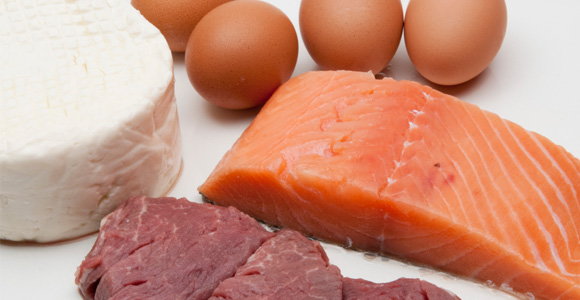Most people over the age of 18 need 10 to 35 percent of their daily calories from protein. When you consume protein, your body breaks it down into amino acids. There are nine essential amino acids that your body cannot synthesize. It is important to obtain all nine essential amino acids from your diet throughout the day.
The best sources of protein contain all nine essential amino acids. These are called high biological value, or complete, proteins, and they also provide other important nutrients. Listed below are the seven best sources of protein.
1. Lean Poultry
Chicken, turkey, Cornish hen, and wild duck or goose are lean poultry sources. Poultry is considered lean if both the skin and fat are removed, and it is cooked using a dry heat method, such as grilling or baking. One ounce of lean poultry provides 7 grams of protein, as well as iron, magnesium, zinc and other important minerals.
2. Fish
Salmon, tilapia, halibut, tuna and mackerel provide 7 grams of protein per ounce, all the essential amino acids, as well as essential unsaturated fatty acids, including EPA and DHA. Some fish varieties, including salmon, are among the few dietary sources of vitamin D.
3. Quinoa
Quinoa is a seed that resembles a grain. It is a good vegetarian source of complete protein and also a good source of fiber. Try substituting quinoa in place of rice or pasta.
4. Eggs & Egg Whites
One egg, two to three egg whites or one-quarter cup egg substitute each contain around 7 grams of protein and all the essential amino acids. The yolk of the egg contains important vitamins and minerals, such as vitamin A, vitamin B12, riboflavin and folate. It is among the few dietary sources of vitamin D. The yolk also contains cholesterol. The Harvard School of Public Health recommends limiting your yolk consumption to no more than three per week if you have diabetes or heart disease.
5. Dairy
Dairy products contain all nine essential amino acids, as well eight grams of protein per serving. Dairy and fortified dairy are good sources of many vitamins and minerals, including vitamin D, calcium and potassium. Low-fat and non-fat dairy products may be a better option for you if you're trying to limit your saturated fat and cholesterol intake.
6. Lean Meat
Lean meat may include beef, pork or veal. It contains all the essential amino acids, 7 grams of protein per ounce, and, like poultry, is a good source of iron and zinc. As with poultry, lean cuts of meat should be trimmed of fat and cooked using a dry heat method, such as grilling.
7. Soy
Soy is another good vegetarian source of protein. There are many soy products that contain all nine essential amino acids, as well as many of the same nutrients as lean poultry or meat. You can also find soy products that taste similar to animal protein products.

Jamie Yacoub, M.P.H., R.D. is a clinical dietitian with a Master's of Public Health in Nutrition. She obtained her Bachelor of Science in clinical nutrition from UC Davis after four years, during which time she participated in internships in several different nutrition environments including Kaiser Permanente and Women, Infants, & Children (W.I.C.). After graduating from UC Davis, she went on to study public health nutrition at Loma Linda University where she obtained her Master's of Public Health in Nutrition. Jamie completed the community nutrition portion of her dietetic internship as an intern for a Certified Specialist in Sports Nutrition. She completed both the food service and clinical portions of her dietetic internship at a top 100 hospital in the nation, where she was hired as the only clinical dietitian shortly after. Jamie now works as an outpatient clinical dietitian and is an expert in Medical Nutrition Therapy (M.N.T.) using the Nutrition Care Process (N.C.P.) including past medical history and current laboratory values as a basis of nutrition assessment.



